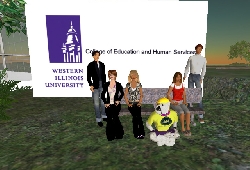COEHS Uses Virtual World to Promote Its Programs, Enhance Academics (revised URL)
February 26, 2008
MACOMB, IL -- Western Illinois University's College of Education and Human Services (COEHS) has recently acquired "land" to enhance its academic offerings. To visit the college's newest site, all one has to do is create an "Avatar" and hop into the world of "Second Life."
Avatar? Second Life? Welcome to the 21st Century.
Second Life (www.secondlife.com ), a 3-D virtual world that opened to the public in 2003, is the size of a small city, with thousands of servers (called simulators) and a resident population of more than 12.4 million and growing. Western's COEHS has leased land (http://slurl.com/secondlife/Teaching%205/204/116/37) on Second Life through the New Media Consortium, a group of universities from across the country, to build academic classrooms and centers which will provide virtual learning opportunities for students and meeting space for faculty.
According to Dawn Sweet, COEHS instructional technology systems manager, Leaunda Hemphill, an instructor in instructional design and technology (IDT), is currently using Second Life to prepare IDT graduate students and their counterparts in China to collaborate on activities related to technology integration in K-12 schools.
"Teachers can use Second Life for such events as virtual field trips, role playing, re-creating worlds and so much more," Sweet added. "For example, Lincoln's boyhood home re-created in Second Life would allow educators to take their students to this land to learn more about Lincoln's childhood; students learning about social responsibility can visit such sites as Camp Darfur and other islands that illustrate social responsibility at work."
COEHS's foray into the virtual world started during the Fall 2007 semester when college officials participated in a college fair on Teen Second Life. From there, the college began exploring virtual uses for the academic realm.
"I'm interested in using virtual worlds, specifically Second Life, to create richer learning experiences for my students beyond the flat web environment I currently use," Hemphill explained. "There is currently a debate among educators whether or not it is worth the effort of preparing learners and teachers to use the environment as the steep learning curve, increased hardware and connectivity requirements are just a few of the issues that need to be considered. In my IDT 534, Issues in Instructional Technology and Professional Development for Educators, course, we will be reviewing these issues as well as the professional development opportunities in Second Life for teachers."
In addition to using Second Life in the classroom, Western's Faculty Innovators, a 24-month faculty professional development program, will use the virtual world for workshops and collaborating with other professionals. The college will also maintain a virtual presence where prospective students can learn more about Western, COEHS programs and University events.
"We have a central goal to provide a challenging and supportive learning environment that is widely recognized as meeting the new technological demands of a global society," COEHS Dean Bonnie Smith-Skripps added. "By becoming a tenant in Second Life, we will be able to foster greater research and development in teaching with technology in the education and human services field."
Other WIU faculty entering the world of virtual reality as a teaching tool include social work Associate Professor Karen Zellmann, who will use Second Life as a mode for her students to participate in role playing and mock interview situations. Students will provide supportive counseling to clients (other Avatars) in Second Life. Jim Allen, art, is currently using Second Life's Virtual Harlem project to display art and lesson plan ideas. Virtual Harlem is a learning environment that lets students experience the Harlem Renaissance of the 1920s and 1930s.
For more information on COEHS' latest venture, contact Sweet at 309/298-2993 or DR-Sweet@wiu.edu.
Posted By: Darcie Shinberger (U-Communications@wiu.edu)
Office of University Communications & Marketing


Connect with us: